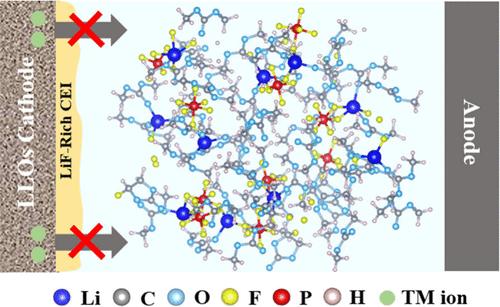Salt-Concentrated Electrolyte Constructing High Elasticity Modulus Interphase for Li-Rich Layered Oxide Cathode
IF 5.4
2区 医学
Q2 MATERIALS SCIENCE, BIOMATERIALS
引用次数: 0
Abstract
Stable electrolytes are urgently required for lithium-ion batteries based on lithium-rich layered oxides (LLOs), which generally suffer from fast capacity and voltage decay at high voltages up to 4.8 V. Herein, we report a salt-concentrated electrolyte consisting of 4 M lithium hexafluorophosphate (LiPF6) salt in ester solvents of fluoroethylene carbonate (FEC) and dimethyl carbonate (DMC) to alleviate the above challenges. The solvent structure in the 4 M electrolyte shows more volatile DMC integrated with Li+ and more free antioxidative FEC compared with a 1 M electrolyte, broadening the operation voltage. Simultaneously, this electrolyte endows a thin yet high elasticity modulus LiF-rich interphase on the LLOs surface, which can effectively prevent diverse side reactions and transition metal migration, consequently improving the electrochemical performance with a voltage decay of only 0.46 mV/cycle and capacity retention of 80.3% after 500 cycles. This simple and effective approach boosts the development of high-energy-density batteries using LLOs.

为富锂层状氧化物阴极构建高弹性模量间相的盐浓度电解质
基于富锂层状氧化物(LLOs)的锂离子电池迫切需要稳定的电解液,而这种电池在高达 4.8 V 的高压下通常会出现容量和电压快速衰减的问题。在此,我们报告了一种由 4 M 六氟磷酸锂(LiPF6)盐在氟乙烯碳酸酯(FEC)和碳酸二甲酯(DMC)酯溶剂中组成的盐浓缩电解液,以缓解上述挑战。与 1 M 电解液相比,4 M 电解液中的溶剂结构显示出与 Li+ 结合在一起的 DMC 更易挥发,而具有抗氧化作用的 FEC 更易游离,从而拓宽了工作电压。同时,这种电解液在 LLOs 表面形成了一层薄而弹性模量高的富含 LiF 的夹层,可有效防止多种副反应和过渡金属迁移,从而提高了电化学性能,其电压衰减仅为 0.46 mV/周期,500 个周期后的容量保持率为 80.3%。这种简单有效的方法促进了使用 LLOs 的高能量密度电池的发展。
本文章由计算机程序翻译,如有差异,请以英文原文为准。
求助全文
约1分钟内获得全文
求助全文
来源期刊

ACS Biomaterials Science & Engineering
Materials Science-Biomaterials
CiteScore
10.30
自引率
3.40%
发文量
413
期刊介绍:
ACS Biomaterials Science & Engineering is the leading journal in the field of biomaterials, serving as an international forum for publishing cutting-edge research and innovative ideas on a broad range of topics:
Applications and Health – implantable tissues and devices, prosthesis, health risks, toxicology
Bio-interactions and Bio-compatibility – material-biology interactions, chemical/morphological/structural communication, mechanobiology, signaling and biological responses, immuno-engineering, calcification, coatings, corrosion and degradation of biomaterials and devices, biophysical regulation of cell functions
Characterization, Synthesis, and Modification – new biomaterials, bioinspired and biomimetic approaches to biomaterials, exploiting structural hierarchy and architectural control, combinatorial strategies for biomaterials discovery, genetic biomaterials design, synthetic biology, new composite systems, bionics, polymer synthesis
Controlled Release and Delivery Systems – biomaterial-based drug and gene delivery, bio-responsive delivery of regulatory molecules, pharmaceutical engineering
Healthcare Advances – clinical translation, regulatory issues, patient safety, emerging trends
Imaging and Diagnostics – imaging agents and probes, theranostics, biosensors, monitoring
Manufacturing and Technology – 3D printing, inks, organ-on-a-chip, bioreactor/perfusion systems, microdevices, BioMEMS, optics and electronics interfaces with biomaterials, systems integration
Modeling and Informatics Tools – scaling methods to guide biomaterial design, predictive algorithms for structure-function, biomechanics, integrating bioinformatics with biomaterials discovery, metabolomics in the context of biomaterials
Tissue Engineering and Regenerative Medicine – basic and applied studies, cell therapies, scaffolds, vascularization, bioartificial organs, transplantation and functionality, cellular agriculture
 求助内容:
求助内容: 应助结果提醒方式:
应助结果提醒方式:


